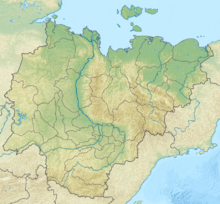Research station Samoylov Island
Coordinates: 72 ° 22 ′ 6 ″ N , 126 ° 28 ′ 29 ″ E
The research station Samoylov Island ( Russian научно-исследовательская станция "Остров Самойловский" ) is a Russian research station located in the Siberian Lena Delta .
It is operated by the Trofimuk Institute of Petroleum-Natural Gas Geology and Geophysics of the Siberian Department of the Russian Academy of Sciences . The main users are the joint LENA expeditions of the Alfred Wegener Institute (AWI) in Bremerhaven , the Arctic and Antarctic Research Institute in Saint Petersburg and the Melnikov Permafrost Institute in Yakutsk , which have taken place annually since 1999 .
location
The station is located about 650 km north of the Arctic Circle on the south coast of the approximately 5 km² large island of Samoyilov in the southern Lena delta, a wetland on the Laptev Sea that is little influenced by humans and is designated as a nature reserve. Tiksi , the most important port of the Sakha Republic , with about 5000 inhabitants is 115 km southeast. It can be reached with the station's own motorboat in four hours, by helicopter in 45 minutes and under ice conditions with the all-terrain truck of the AWI in eight hours. Tiksi is also home to the nearest airport , which connects the place with Moscow , Saint Petersburg and Yakutsk.
history
Scientific exploration of the Lena Delta began in the second half of the 19th century. From 1882 to 1884 there was an arctic research station on the island of Sagastyr , which Russia had set up as part of the First International Polar Year . There took staff captain Nikolai Juergens (1847-1898), the physician Alexander Bunge (1851-1930) and the mathematician Adolph owner (1854-?) Internationally coordinated meteorological and geomagnetic observations.
The research station on the island of Samoyilov was opened in 1998 in an existing wooden house anchored with piles in the permafrost ground for the administration of the Ust-Lenski nature reserve . In 2005 it was supplemented by an extension that is directly connected to the old house and officially reopened as a Russian-German station a year later. At that time, the station was only manned in summer. Year-round use has only been possible since the new station opened on September 23, 2013.
description
The new main building of the research station consists of three wings and has a covered area of 1214 m². It has 10 bedrooms with a total of 30 beds, 4 living rooms, 7 laboratories, 5 kitchens, a meeting room, a fitness room and 12 other rooms. There is also a 313 m² garage that can accommodate a caterpillar transporter , quads , snowmobiles and several boats. Power is supplied by a diesel generator (1256 KVA) and a 500 watt wind turbine. The bedrooms and work rooms of the old station building continue to be used seasonally.
The station team consists of six people all year round and eight in summer. In addition, 25 guests can be accommodated at the same time. The ultra-modern laboratories are equipped with high-performance precision equipment.
climate
There is an arctic climate with permafrost in the vicinity of the station. The ground is frozen to a depth of 500 to 600 m. Only in summer does a 30 to 50 cm thick layer thaw on the surface.
The mean annual temperature is −13.6 ° C. The coldest month is February with an average of −33.2 ° C, the warmest is July with an average of 9.3 ° C. The wind mostly blows from the northeast with an average speed of 4.35 m / s. In the year, an average of 319 mm of precipitation falls as snow or rain.
research
The Lena Delta plays a key role in understanding processes in the permafrost soil of the Siberian Arctic. Long-term research programs concern the year-round monitoring of climate and permafrost, river hydrology , geomorphology , permafrost dynamics, arctic coastal dynamics and hydrobiology . Research into the interactions between the local ecosystem and the atmosphere should enable the assessment and prediction of climate changes in the region. One focus is questions of the implementation and emission of greenhouse gases , especially methane . Other studies concern the development of the landscapes in the Lena Delta due to changed thawing processes.
Individual evidence
- ↑ a b c d Samoylov Island Research Station. A basis for Russian-German permafrost research in Siberia , Alfred Wegener Institute, October 20, 2015, accessed on November 1, 2016.
- ↑ a b c d e Samoylov station on the homepage of the INTERACT project (English), accessed on October 4, 2017.
- ↑ Erki Tammiksaar, Natal'ya Georgievna Sukhova: The Polar Station in the Lena Delta . In: Susan Barr, Cornelia Lüdecke (Ed.): The History of the International Polar Years (IPYs) . Springer, Berlin, Heidelberg 2010, ISBN 978-3-642-12401-3 , pp. 80–86 , doi : 10.1007 / 978-3-642-12402-0 ( limited preview in Google book search).
- ↑ А. А. Пахомов: О научных исследованиях учреждений Якутского научного центра Сибирского отделения РАН по изучению арктических территорий Республики Саха (Якутия) и шельфов моря Лаптевых и Восточно-Сибирского моря . In: Арктика: экология и экономика . No. 2 (14) , 2014, pp. 24–30 (Russian, PDF ; 969 kB).
- ↑ Julia Schneider, Guido Grosse, Dirk Wagner: Land cover classification of tundra environments in the Arctic Lena Delta based on Landsat 7 ETM + data and its application for upscaling of methane emissions . In: Remote Sensing of Environment . tape 113 , 2009, pp. 380–391 , doi : 10.1016 / j.rse.2008.10.013 (English). hdl : 10013 / epic.31719 .

